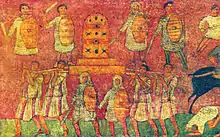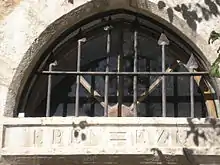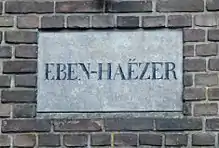Eben-Ezer
Eben-Ezer (Hebrew: אבן העזר, ’eḇen hā-‘ezer, "the stone of help") is a location that is mentioned by the Books of Samuel as the scene of battles between the Israelites and Philistines. It is specified as having been less than a day's journey by foot from Shiloh, near Aphek, in the neighbourhood of Mizpah, near the western entrance of the pass of Bethoron. However, its location has not been identified in modern times with much certainty, with some identifying it with Beit Iksa, and others with Dayr Aban.[1]


Historical mentions
It appears in the Books of Samuel in two narratives:
- In the first narrative (1 Samuel 4:1–11), the Philistines defeat the Israelites, even though the Israelites brought the Ark of the Covenant onto the battlefield in hope of it bringing them a divinely assured victory. As a result of the Philistine victory and the Ark's presence on the battlefield, it was captured by the Philistines, and not returned until many months later (1 Samuel 6:1–2).
- In the second narrative (1 Samuel 7:2–14), the Israelites defeat the Philistines, after Samuel has offered a sacrifice. Samuel puts up a stone in memorial and names it Eben-Ezer (the placename in the previous narrative resulting from this). This monument is referred to in the hymn "Come Thou Fount of Every Blessing".[2]
Modern-day placement
It is currently accepted among many Israeli archaeologists and historians to place the Eben-Ezer of the first narrative in the immediate neighborhood of modern-day Kafr Qasim, near Antipatris (ancient city Aphek), while the second battle's location is deemed to be insufficiently well-defined in the Biblical text. The other proposed site is called "Isbet Sartah".[3][4] Some scholars hold that there were more than one Aphek. C.R. Conder identified the Aphek of Eben-Ezer[5] with a ruin (Khirbet) some 3.7 miles (6 km) distant from Dayr Aban (believed to be Eben-Ezer), and known by the name Marj al-Fikiya; the name al-Fikiya being an Arabic etymological variant of Aphek.[6] Eusebius, when writing about Eben-ezer in his Onomasticon, says that it is "the place from which the Gentiles seized the Ark, between Jerusalem and Ascalon, near the village of Bethsamys (Beit Shemesh)",[7] a locale that corresponds with Conder's identification. The same site, near Beth Shemesh, has also been identified by Epiphanius as being Eben-ezer.[8]
See also
References
- C. R. Conder, "Notes from the Memoir", Palestine Exploration Quarterly, vol. 18, London 1876, p. 149; Conder & Kitchener, The Survey of Western Palestine, vol. iii (Judaea), London 1883, p. 24
- "Here I Raise My Ebenezer!". Apologeticspress.org. Retrieved 4 April 2012.
- Kochavi, Moshe (1981). "The History and Archeology of Aphek-Antipatris: A Biblical City in the Sharon Plain". Biblical Archaeologist. 44 (2): 75–86. doi:10.2307/3209863. JSTOR 3209863. S2CID 133373668.
- Location and map of Izbet Zartta or Eben-Ezer
- The account in 1 Samuel 4:1 of the battle at Aphek and Eben-ezer
- North, Robert (1960). "Ap(h)eq(a) and 'Azeqa". Biblica. 41 (1): 61–63. JSTOR 42637769.
- Eusebius Werke, Erich Klostermann (ed.), Leipzig 1904, p. 33,24.
- Epiphanius' Treatise on Weights and Measures - The Syriac Version (ed. James Elmer Dean), University of Chicago Press 1935, p. 73 (§ 68)
External links
 Media related to Eben Ezer churches at Wikimedia Commons
Media related to Eben Ezer churches at Wikimedia Commons- . The American Cyclopædia. 1879.
- . Collier's New Encyclopedia. 1921.
